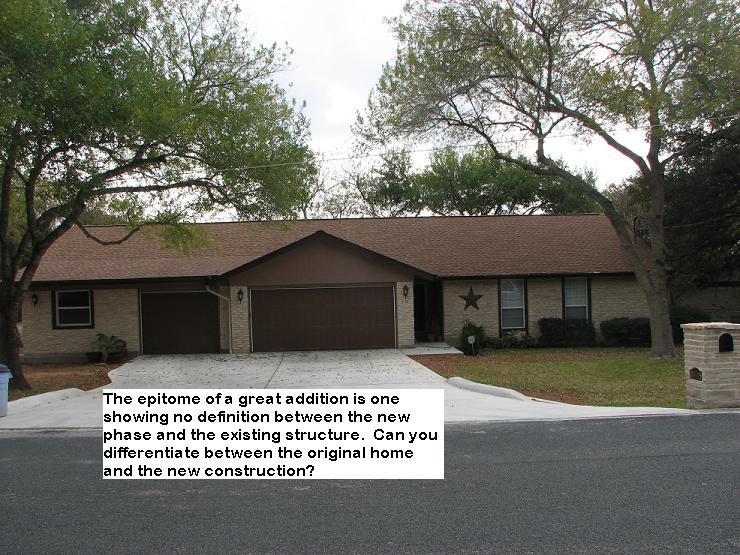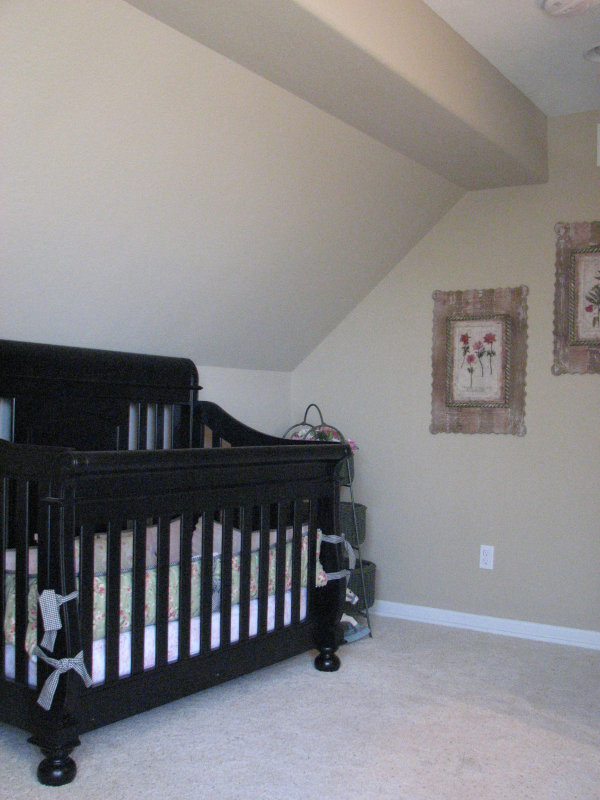You have contemplated and dreamed of an addition to your home for years but now it's time for you to make a decision as to how you accomplish your basic needs for living. Certain changes in your lifestyle have dictated an expansion. Your living space has grown more crowded over time with additional family members being added as children, extended family members, or you may now find yourself having to provide care for an elderly family member. Any and all of these life changing situations can add stress to your daily lifestyle creating the need for additional living space or home improvements Austin.


As our children grow older they generally require more space and sometimes privacy. This sparks a need for additional bedroom space alone once an aging relative or spouse is introduced into the original home's square footage who requires special care. Here, privacy can truly become an issue just to keep everyone happy while underneath the same roof. Perhaps even private entrances will be required for some of the home's new residents. These private entries could be required to begin a new accessible route if there are ADA compatibility issues involved.

It's time to find yourself either a qualified architectural firm and residential remodeling contractor or a local experienced residential construction contractor with in house design capabilities who can build what is designed. The latter situation is usually your best shot at getting what you basically need to solve your living situation problems allowing you to cut out the beyond budget frills. You will also save on the soft costs of your construction project that have nothing to do with the structual building process itself. Many local residential contractors are quite capable of pushing out a wall in your home and putting a top on the structure. This capability is based on both their experience and knowledge of all the building trades, especially the framing aspect that will be involved. Actual experience in this particular facet of the project could proove to be very helpful for visualizing the construction and it's possibilities. Has this contractor ever done this kind of project before? Does he himself have skilled experience or does he appear to be a drive by limited contractor at the mercy of his subcontractor's capabilities? Any depth of design is totally based on experience. You will need to completely check out the contractor's references and any memberships in local business organizations like the Better Business Bureau. What kind of rating does the residential remodeling professional have and how long has he been an accredited member? Does the company have both general liability and Workman's Comp insurances and did the company offer you a certificate of insurance verifying their coverage. You need the kind of information that can't be paid for and posted by the residential remodel contractor in question. Don't be taken in by contractor listing and referral sights that promise you successful and competent businesses. They were listed there for one and only one reason, somebody paid for the listing fee. Membership to national associations like NARI reflect only a self paid fee but says nothing about the contractor's experience and creativity. That only comes from past customer's testimonials that you can fact check.
Now how about the competitive bid prices you have collected? A good rule of thumb is to toss out the lowest and highest numbers and go with the mid price. This is true if and only if the company can pass the litmus test outlined above. However, the project should be based on overall quality and remember you usually get what you pay for. This situation will be solved with how the personalities of you and the contractor mesh together. You must be able to communicate with this person who has come into your life throughout the construction process while keeping a level head for problem solving. There will be problems because every construction and remodeling project has at least one. There also needs to be a norm in the way the proposal is written. Has the bidder been transparent and detailed to you in writing what is being covered within the bid? Are there meaningful and fair allowances contained within the bid covering the materials that will be used but have no specifications as of yet? You must do your homework before entering into any contract without regret.

Tags:
Austin,
Texas,
residential construction contractor,
how-to,
ADA accessible,
accessible routes,
aging in place remodeling,
aging in place home modifications,
aging in place home improvements in Austin,
older structures,
residential remodeling,
ADA remodeling,
home remodeling,
aging in place construction,
accessibility home remodeling in Austin,
accessible home remodeling,
disability home remodeling in Austin,
aging in place specialist,
aging in place services,
aging in place design,,
renovation contractor in Austin, texas,
home modifications Austin, Texas,
home improvements Austin,,
accessibility remodelers in Austin,
house remodeling Austin,
home remodeling Austin, Texas
T-Square Company is a local design/build General Contracting firm registered with the City of Austin, Texas. We have a competent team of in house craftsmen for your structural job aspects. They are complemented by a force of long time affiliated subcontractors holding a masters license with the State of Texas. This adds to the effort to accomplish our turn key new and remodel residential and commercial projects in the areas of plumbing, electrical, HVAC, fire sprinklers, and yard irrigation. Since working together for over ten years we are able to work through problems that arise on every job and provide our clients with a more cost effective outcome. We always incorporate energy efficient construction techniques in both our new and building upgrades. Our remodels and tasteful additions always blend with and accent the original structure. We are accessibility experts holding nationally accredited CAPS and Universal Design (UD) certificates to assist in removing any architectural barriers limiting mobility within the home. We offer complete home modifications for independent living in Austin. Let us show you how to adapt your home to fit your ever changing needs. Perhaps an expansion to a defined living space would solve a changing living situation. How can this be accomplished without altering your home's basic footprint? How can you go about this without a costly addition? Maybe it's time to look under the hood, so to speak, for a solution that is right under your existing homes roof line.
How about pushing a certain room's perimeter out into your existing unused attic space to create attic remodeling? You can expand a small child's bedroom space to create a play or activity room. Storage needs can be met by taking in part of the attic to create a closet or other additional storage area. Entertainment areas can be created without taking square footage out of the living space once the equipment is installed beyond the existing inner wall line into the attic space.
How you accomplish adding this additional square footage can be quite easy if you obtain the advice of a qualified building professional. Any reputable residential building contractor can give you direction for such a task so that your roof's structural integrity is not put in jeopardy. You must not under any circumstance interrupt the structural balance of your roof. Not only could you cause a structural failure of the roof itself but other areas of your home could be affected by this interruption in stability.
Structurally you may need to add headers or beams or just maybe a few additional purlin braces can be added to carry the new roof load. If headroom is a problem a dormer addition changing the existing roof line can be constructed. You can cover this new dormer area with either a shed or gable type roof which will be dictated by the elevation of your home so that it blends and matches. By all means, if you don't know if what you're about to do is structurally sound in judgement and support don't be afraid to ask a professional.
Our residential customers in Austin, Texas can benefit from our enormous construction experience and national accreditations enabling us to offer our many services.
A Newborn's Nursery Taken From The Adjacent Unused Attic Space

Tags:
Austin,
Texas,
how-to,
efficiency,
residential remodeling,
attic remodeling,
home modifications Austin, Texas,
home improvements Austin,,
residential remodeling contractor in Austin,
home remodeling Austin, Texas,
residential remodeling company in Austin, Texas
Now that you've worked so diligently to attain the most efficient envelope for your building it's time to consider the finer points and a few energy minded construction techniques. This is why home remodeling Austin, Texas is a unique problem and furthermore why professional residential remodelers exist. From here on out you will be dealing with the penetrations going through your envelope perimeter that are deducting from all your efforts. These areas include not only the electrical boxes, wires, pipes, and registers that are coming through your walls, floor, and ceilings,but in particular the doors and windows that connect us to the outside.
Austin house remodeling criteria demand that any penetrations concerning your utilities must be dealt with using expanding foams, caulks, or gaskets that limit infiltration into your envelope. You can use clear paintable caulks in conjunction with all your interior trim eliminating small leaks that add up to large problems. You can also caulk your A/C buckets to the ceiling before replacing the grilles. Use insulation dams above attic stair units and weatherstrip the pull down door to the ceiling. Repeat this procedure at any additional attic skuttles within your building.
Your return air closet can also be a conditioned air thief. Caulk all inside corners of the closet and seal your air handler to the platform it rests upon. Weatherstrip the closet door. If you have a gas furnace you can either remove the closet ceiling or install combustion air pipes that connect the closet to the unconditioned attic above.
Now to attack the most wasteful of all the efficient envelope penetrators that connect us to the great outdoors-your windows. They make up a great percentage of surface area in your now upgraded and insulated exterior walls. You must access whether or not to replace the original leaky windows and what value they add while preserving the look of your exterior. If you choose to keep them, either efficient storm windows or insulating shutters may be installed on the interior. If, on the other hand, you favor replacing them always remember a good rule of thumb. A single pane of glass only offers an R-1 resistance to the outside. You are basically dealing with aesthetics so don't be taken in by all the bell and whistle talk. The main specification to consider is the E-factor concerning how well light is transmitted into the building helping with direct gain problems during the summer months.
All solid exterior doors offer insulating qualities through their makeup and must be weatherstripped. If your doors contain glass inserts treat them as windows installing insulating shutters on the interior or a storm door on the exterior. Any penetrations through the conditioned envelope reduces it's total efficiency.

Tankless Hot Water Heaters DON'T Waste Energy Heating Water

Check out Part 1: Ceilings which covers your attic wastes
Check out Part 2: Walls which covers your wall R-factors and underpinning
Phote Credit: Compact fluorescent...By Mike Dykstra
Tags:
how-to,
efficiency,
aging in place home improvements in Austin,
older structures,
energy minded construction,
handicap home modifications,
home remodeling,
accessibility home remodeling in Austin,
accessible home remodeling,
home modifications for independent living,
elder construction,
home modifications Austin, Texas,
home improvements Austin,,
accessibility remodelers in Austin,
house remodeling Austin,
home remodeling Austin, Texas,
house remodeling Austin, Texas,
home remodels Austin,
home modifications for independent living Austin
Now that you've taken care of the energy being wasted "through the roof" how about those walls and what energy minded construction techniques can be utilized? What type of construction makes up your walls and what are the best ways to go about eliminating some of the waste caused by air infiltration? Let's define what home remodeling Austin, Texas means.
Any remodeling contractor will tell you that Very old buildings have wall construction which is limited only by the materials that were available at the building sight for any specific time. These structures were normally composed of sod, masonry, or logs that were chinked with mud set into their joints relying on the principle of thermal mass. By building thicker walls the same logic of the R-factor was used. It took longer for outside temperatures to transfer into the building through these massive resistant walls into the living space.
Once lumber became available it was used at a premium. The presence of clapboard or weather board construction came about using one by (one inch thick) boards in varying widths on both sides of a 2x4 stud forming the outside walls.
The joints between the boards allowed air to infiltrate the building. Batten boards were nailed over these joints on the exterior to eliminate some of the air flow and later cheesecloth covered by wallpaper was applied on the inside boards. The walls still had too much air infiltration relying on the dead air space and the composition of the wood itself to comprise the R-factor. Finally 1/4" sheetrock was applied over the wallpaper as a first generation drywall application.
If this clapboard system is plaguing your building you must access which side of the wall you need to attack. Do you need new exterior siding that allows you to install and bury additional rigid insulation or desire a newer looking drywall finish on the interior? The only way to gain access to your stud space for applying batt insulation is to remove one side of the clap boards. The kraft face must be turned toward your living space to create a vapor barrier against the outside and R-13 is the thickest product you can place in a four inch cavity. Don't be misled by an offer using a blown in product that can be held up by wiring and never reach the bottom of the wall cavity which defeats the whole process.
Once you have accomplished this task you have helped to maintain your envelope but you need to look down. If your floor is on a pier and beam structure do you have an underpinning present? It's purpose is to stop the wind from robbing you of additional infiltration from below your floor. If present, the underpinning can eliminate having to install insulation between your floor joist. It acts by literally raising the constant temperatures that existing naturally below ground. This natural occurence will temper the crawl space beneath your floor joists and prevent energy robbing infiltration. You now have a reasonably efficient envelope given your existing situation.
Check out Part 1: Ceilings which covers your attic wastes
Check our Part 3: The Envelope covering penetrations and their energy wastes
Photo Credit: Energy Savings By Prophet of the Haze

Tags:
how-to,
efficiency,
aging in place remodeling,
aging in place,
aging in place home improvements in Austin,
older structures,
energy minded construction,
home remodeling,
accessibility home remodeling in Austin,
disability home remodeling in Austin,
home modifications for independent living,
aging in place specialist,
aging in place services,
aging in place design,,
disability home modifications in Austin,
home modifications Austin, Texas,
home improvements Austin,,
house remodeling Austin,
home remodeling Austin, Texas,
house remodeling Austin, Texas,
home remodels Austin
So you have recently purchased or already own a building with character but feel like it's wasting your hard earned money causing high energy bills. What are some of the best and most cost energy minded construction techniques in Austin, Texas you can use to help lower those "through the roof" expenses? You need to understand primarily that your ceiling is the only common denominator between your costly conditioned living space and the root of your problem---the attic.
The greatest retrofit solution concerning home remodeling Austin, Texas is the resistance factor (R-factor) you can add above your ceiling in the form of insulation to slow down temperature exchanges and the amount is determined only by the space that you have. If you own a building without any insulation then insulating the ceiling above the walls and floor causes the most radical changes in the way the structure responds to temperature differentials. Lay in Kraft faced batts with the paper next to your ceiling to create a vapor barrier. If your attic has old preexisting insulation add more on top of this in the form of unfaced batts running perpendicular to your ceiling joists or apply the blown in type.
Remember that insulation works best when there is air surrounding each of the fibers or filaments comprising it's makeup that forms the resistance. Settled and stomped down areas defeat the purpose by transferring temperature easier between the fibers themselves that are touching one another. Think of your attic as a heat producing battery that pushes the summer heat down through your ceiling into the conditioned space. The air expands as the temperature increases and once the attic ventillation is overcome by sheer volume it continues to hold that increasingly heated air only to transfer the heat directly through your ceiling causing your A/C to cycle more often. Conversely in the winter the cold intrinsic attic air takes advantage of the principle of heat rising and becomes a collecting sponge for your expensive heated air. The presence of adequate insulation fixes both situations because the greater the R-value the better the fix.
Check out Part 2: Walls covering R-factors within your walls
Check out Part 3: The Envelope covering penetrations and their energy waste
Photo Credit: lightbulb By trulyshyazn

Tags:
how-to,
efficiency,
older structures,
energy minded construction,
home remodeling,
home modifications for independent living,
handicap remodeling contractors in Austin,
handicap remodeling contractors,
home modifications Austin, Texas,
home improvements Austin,,
accessibility remodelers in Austin,
house remodeling Austin,
home remodeling Austin, Texas,
accessibility designs Austin Texas,
house remodeling Austin, Texas,
home remodels Austin,
home modifications for independent living Austin
















